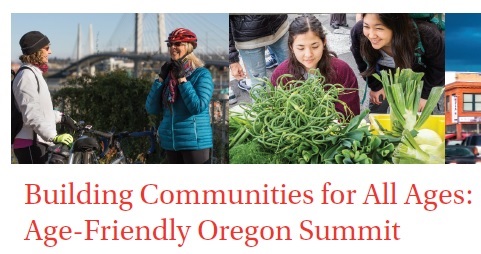
By Neal Lemery, for the Pioneer
In ten years, our population of seniors 75 years and older will double. Yet, only 1% of our housing has the amenities that will allow seniors to stay in their own homes.
How do we make our housing and our communities more friendly to our aging population?
That was a question at the recent Building Our Communities for All Ages conference sponsored by the American Association of Retired Persons (AARP) in Portland. Over 200 people, mostly community volunteers and professionals, gathered to hear success stories and challenges from experts dedicated to improving the quality of life for our communities and seniors.
We need age-friendly housing and neighborhoods, topics which are especially challenging in rural Oregon, where funds for public improvements, housing, retirement living, and transportation are hard to come by.
We want to encourage people to grow old in their homes. It is less costly, more efficient, and prolongs both length of life and quality of life. Yet, 50% of seniors spend more than 30% of their income on housing. 80% of rural senior Oregonians own their own home, yet 40% of houses need major modifications for aging population, and only 1% of housing is fully equipped to allow aging seniors to safely remain in their homes.
80% of Oregon seniors own their own homes, but are increasingly “house rich, cash poor”, as rising property values increase property taxes and other costs also grow, while incomes remain limited.

“You cannot do anything alone. It’s about collaboration. Sometimes it requires compromise,” Portland Mayor Ted Wheeler told the conference. “Young people thrive when they have an older adult who cares about them and engages with them – making connections.”
“70% of the reasons for a long, healthy life are products of social engagement and activities. The other 30% are related to genetics and quality of health care,” urban activist Gil Penalosa said.
“It’s not retirement, it’s re-hirement,” he said. “People are living longer, and need to be engaged in their community in order to live healthier, longer lives.”
His worldwide planning group takes a radical view of making public space people friendly. He brings in art, pedestrian-friendly spaces, and a revitalized sense of community to places all over the world. His message is simple: start small with inexpensive changes that allow people to mingle, and develop relationships with each other. His premise is “8-80”, creating public spaces for both the eight year old and the 80 year old. (https://880cities.org. )
A healthy community requires eight dynamic factors: housing, transportation, parks and public spaces, health and community service, respect and inclusion, social participation, and communication and information.
Aside from the structural needs of housing, healthy social interactions and opportunities for physical activity are critical.
“Loneliness is just as lethal as smoking five cigarettes a day,” Sharon Meieran Multnomah County Commissioner, said.
A decline in our physical activity also increases our risk for diabetes. 25 years ago, 9% of Oregonians were obese. Today, that rate is 29%. By building sidewalks and improving parks and other pedestrian friendly facilities in our community, we improve our health and our ability to remain in our homes.
Rural Oregonians have additional challenges. A majority of us are sixty miles or more away from health care, and live more than ten miles from a full-service grocery store. Public transportation is limited, and many people require door to door bus service.
More information on the conference and Oregon’s responses is available at https://states.aarp.org/oregon/gov-brown-to-kick-off-age-friendly-summit


